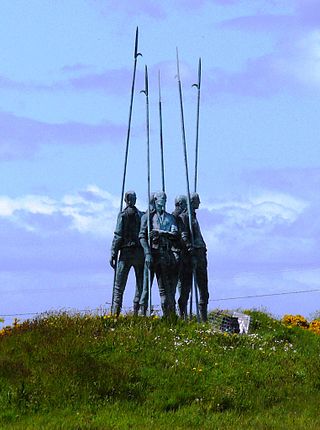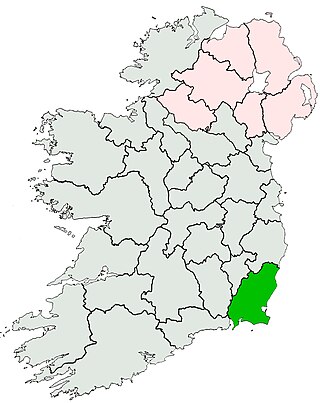Battle
The attack on Enniscorthy began at about 1 p.m. All the town's defences were drawn up outside the Duffry Gate, where several roads converged on the town, on the western approach. Only Captain Snowe's Company of the North Cork Militia remained within the town, where they held the stone bridge over the Slaney. The initial approach to the town by the rebels consisted of a 200 strong corps of men armed with muskets, who proceeded down the centre, flanked each side by a corps of pikes. This attack was driven back by sustained army and loyalist musket fire and by the Yeoman Cavalry, forcing the rebels to hide behind the ditches. At this moment is it suggested that Fr John Murphy recommended that the cattle being herded at the rear be brought forward, and used in place of a heavy cavalry charge. Miles Byrne suggests that "…thirty or forty of the youngest and wildest of the cattle brought from the rear of his column, goaded on by some hundreds of brave, decided pikemen…" rushed at the lines of infantry outside the Duffry Gate. [4] This coincided with rebels within the suburbs of the town setting fire to thatched houses, creating great concern within the defenders ranks, and a retreat into the town's streets. After sustained house to house fighting, the troops defending the gate withdrew to a stone bridge over the River Slaney. A determined defence lasted for about three hours, the loyalist forces had expended their ammunition. Meanwhile at the bridge, a young rebel leader, Thomas Synnott, had waded across the Slaney at Blackstoops, above the town, and had put in a serious fight against the North Corks at the bridge. After having driven all the rebels out of town [2] : 96 they were ordered to abandon the town and withdraw to Wexford, which they did alongside a terrified multitude of men, women and children fleeing the burning town. [5] In the action, the garrison and yeomanry had killed up to 500 insurgents at a cost of 90 of their own dead. [6] [ check quotation syntax ] """
Aftermath
According to the historian Maxwell, the town's Protestants saw a merciless night attack as almost certain. Throughout the fight, Catholic residents had been supporting the rebels by shooting loyalists from their windows. Of the many fugitives, the weakest were carried on cavalry horses or otherwise abandoned to their fate, including infants and the elderly.
The rebels were brutal and vengeful in occupying their captured town. They were setting up a formidable encampment of 10,000 men on the nearby heights of Vinegar Hill and were able to roster forces to garrison Enniscorthy, whose streets were littered with dead and dying while flames continued to rage. 478 dwelling houses were destroyed in addition to commercial premises. [2] : 97

County Wexford is a county in Ireland. It is in the province of Leinster and is part of the Southern Region. Named after the town of Wexford, it was based on the historic Gaelic territory of Hy Kinsella, whose capital was Ferns. Wexford County Council is the local authority for the county. The population of the county was 163,527 at the 2022 census.

Enniscorthy is the second-largest town in County Wexford, Ireland. The town is located on the picturesque River Slaney and in close proximity to the Blackstairs Mountains and Ireland's longest beach, Curracloe.

Wexford Harbour in County Wexford, Ireland is the natural harbour at the mouth of the River Slaney. In earlier times, the area occupied by the harbour was considerably larger than it is today, up to ten miles (16 km) wide at its widest point, with large mud flats on both sides. These were known as the North Slob and the South Slob from the Irish word slab, meaning mud. It contained several islands, among which the large island of Beggerin was known to be a safe refuge for early Christian settlements.

The Battle of Vinegar Hill was a military engagement during the Irish Rebellion of 1798 on 21 June 1798 between a force of approximately 13,000 government troops under the command of Gerard Lake and 16,000 United Irishmen rebels led by Anthony Perry. The battle, a major rebel defeat, took place on 21 June 1798 on a large rebel camp on Vinegar Hill and in the streets of Enniscorthy, County Wexford and marked the last major attempt by the rebels to hold and control territory taken in Wexford.

The Battle of Oulart Hill took place on 27 May 1798 when a rebel gathering of between 4,000 and 5,000 annihilated a detachment of 110 militia sent from Wexford town to stamp out the spreading rebellion in County Wexford.

The Battle of Three Rocks was a United Irish victory during the Wexford Rebellion, a part of the 1798 rebellion, against a British artillery column marching to reinforce Wexford town against anticipated rebel attack.
John Kelly lived in the town of Killanne in the parish of Rathnure, west of Enniscorthy, in County Wexford in Ireland, and was a United Irish leader who fought in the Irish Rebellion of 1798. Kelly was obviously well known to rebels and loyalists alike during the short duration of the Wexford Rebellion but almost nothing is known of him outside this time. He was one of the leaders of the rebel victory at the Battle of Three Rocks which led to the capture of Wexford town but was later seriously wounded while leading a rebel column at the Battle of New Ross.

The second Battle of Arklow took place during the Irish Rebellion of 1798 on 9 June when a force of United Irishmen from Wexford, estimated at 10,000 strong, launched an assault into County Wicklow, on the British-held town of Arklow, in an attempt to spread the rebellion into Wicklow and to threaten the capital of Dublin.
Anthony Perry, known as the "screeching general" was one of the most important leaders of the United Irish Wexford rebels during the 1798 rebellion.

John Murphy was an Irish Roman Catholic priest of the Roman Catholic Diocese of Ferns, who is mainly remembered for his central role in the Irish Rebellion of 1798 in County Wexford, which is sometimes known as the Wexford Rebellion. He led the rebels to one of their initial victories over a government militia at Oulart Hill, and in the following weeks became one of the rebellion's main leaders.
Events from the year 1798 in Ireland.
"Boolavogue" is an Irish ballad commemorating the campaign of Father John Murphy and his army in County Wexford during the Irish Rebellion of 1798. It was composed by Patrick Joseph McCall in 1898, the centenary of the Rebellion.
The Battle of the Harrow took place on 26 May 1798 and was the first clash of the Irish Rebellion of 1798 in County Wexford. It was fought between government forces and United Irishmen insurgents under the leadership of a local priest, John Murphy who had mobilized following reports of atrocities by the yeomanry during the rebellion led by the United Irishmen revolutionary organisation.
Beauchamp Bagenal Harvey was a barrister and a commander of the United Irishmen in the Battle of New Ross during the 1798 Rebellion.

The Wexford Rebellion refers to the events of the Irish Rebellion of 1798 in County Wexford. From 27 May until 21 June 1798, Society of United Irishmen rebels revolted against British rule in the county, engaging in multiple confrontations with Crown forces. The most successful and destructive rising in all the counties of Ireland, United Irishmen rebels experienced a number of early successes in the county despite being seen as a relatively loyal county by the Dublin Castle administration due to a series of military victories. However, the tide soon turned against the United Irishmen in Wexford as Crown forces poured into the region, engaging in a brutal counterinsurgency which indiscriminately targeted suspected rebels and eventually suppressed all rebel activities in the county.

County Wexford is a county located in the south-east of Ireland, in the province of Leinster. It takes its name from the principal town, Wexford, named 'Waesfjord' by the Vikings – meaning 'inlet (fjord) of the mud-flats' in the Old Norse language. In pre-Norman times it was part of the Kingdom of Uí Cheinnselaig, with its capital at Ferns.
John Henry Colclough was a United Irishman, who was executed in Wexford following the Irish Rebellion of 1798.

Wexford Bridge is a road bridge in Wexford, the county town of County Wexford in Ireland. It crosses the mouth of the River Slaney from Wexford town on the west bank to Ferrybank on the east bank. It carries the R741 road from Wexford towards Dublin and the north. The bridge consists of 7 spans of maximum length 63 metres and 12 metres wide, made of continuous steel girders carrying composite concrete slabs. Including the approach roads, the total length of the bridge is 590 metres, of which 380 metres are over water.

The Battle of Clonard occurred on 11 July 1798 near Leinster Bridge in the town of Clonard, County Meath, during the Irish Rising of that year. A combined force of between 2,000 and 4,000 United Irishmen engaged a force of 27 British loyalist militia troops led by Lieutenant Thomas Tyrrell over 6 hours in an attempt to cross the River Boyne. The defenders held the fortified house until they were reinforced by a Sergeant and 11 men of the Northumberland Fencibles and 15 men of the Kinnegad Cavalry under the command and including Lt Edward Haughton when the rebels were routed and retreated to Carbury. The attack on Clonard was a disastrous failure and a severe blow to the surviving rebels. Many of the Kildare rebels returned to their homes while many of the Meath men were dissuaded from joining the rebellion by the defeat and due to much of their existing stocks of ammunition being wasted in the battle.












